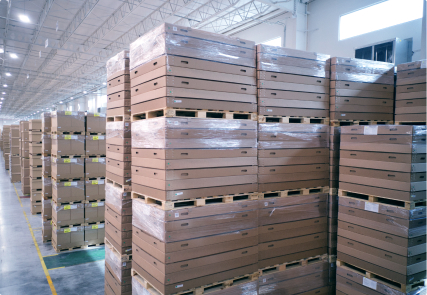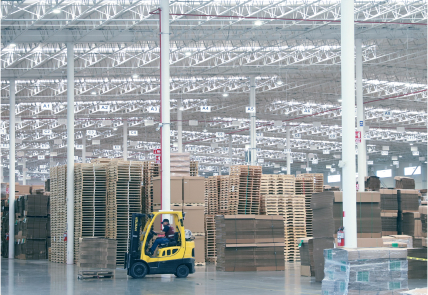Our returnable packaging offers a cost-effective option for your products’ distribution, handling, and storage. Our packaging products are all custom-designed to meet the needs of our customers and provide safe transport throughout the supply chain.




In-house program management that ensures customers timelines and budgets are met.
Innovative designs that efficiently cube-out over road trailers and sea containers.
Over twenty-five proven engineers with experience exceeding 15+ years offer the experience you need to get the job done right.
From inbound material inspections, ISTA testing, and ISO 9001 manufacturing we ensure a quality product every time.
We support the just-in-time manufacturing processes of our customers and get the right solutions delivered to the right place, at the right time.
Got a challenge or issue – just pick up the phone and we’ll be there for you from prototyping through delivery.

Our returnable packaging is engineered to meet the exacting standards of your business, and includes the features you need including lids, straps, stacking, and nesting.
Here’s an overview of the returnable packaging solutions we offer:
100% recyclable cardboard
EcoVadis 71st Percentile
In-House Foam Recycling
Environmentally friendly reusable containers are cost-efficient and provide superior performance and return on investment. Recycle reusable container systems at the end-of-life to reduce carbon emissions.


ABP started as a supplier to Detroit’s auto industry and we’ve expanded to support many different customers and industries
Operations in US and Mexico and integrated partnerships throughout Europe and Asia
Returnable packaging is a type of packaging material that is designed to be used multiple times for the transportation and storage of products. This can include items such as plastic crates, pallets, and reusable containers. Returnable packaging is typically more durable and sturdier than expendable packaging and is designed to withstand multiple trips through the supply chain.
Returnable packaging is often made from materials that are strong, yet lightweight, such as plastic or metal. These materials are able to withstand wear and tear and can be easily cleaned and maintained between uses. Returnable packaging can also be designed to be stackable, allowing for more efficient use of space during transportation and storage.
The use of returnable packaging can offer several benefits, including reduced costs and environmental impact. While returnable packaging may be more expensive initially, its ability to be used multiple times can ultimately lead to cost savings over time. Additionally, the use of returnable packaging can reduce waste and minimize the environmental impact associated with the production and disposal of expendable packaging.
Overall, returnable packaging is a sustainable and practical solution for businesses looking to transport or store products in a safe and cost-effective manner, while also minimizing their environmental impact.
Returnable packaging solutions can be made from a variety of materials, depending on the specific needs and requirements of the product being transported or stored. Some common materials used in returnable packaging include:
Plastic: Returnable packaging such as crates, pallets, and containers can be made from different types of plastic, including polyethylene, polypropylene, and polycarbonate. These materials are durable, lightweight, and easy to clean, making them ideal for multiple use cases.
Metal: Returnable packaging such as metal crates, pallets, and containers are sturdy and long-lasting, making them suitable for heavy-duty applications.
Glass: Glass jars and bottles can be used as returnable packaging for certain products such as beverages, due to their ability to be washed and sterilized for reuse.
Wood: Returnable packaging such as pallets can be made from wood, providing a durable and sustainable option for transporting and storing products.
Composite materials: Some returnable packaging may be made from composite materials, which combine different materials such as plastic and metal to create a strong, durable product that is resistant to wear and tear.
Returnable packaging solutions are typically designed to be durable and able to withstand multiple uses, which means they often require a more robust material than expendable packaging.
Returnable packaging offers several benefits, including:
Cost savings: Although returnable packaging may require a larger upfront investment compared to expendable packaging, the ability to reuse the packaging multiple times can ultimately result in cost savings over time.
Sustainability: Returnable packaging is a more sustainable option than expendable packaging, as it reduces waste and minimizes the environmental impact associated with the production and disposal of expendable packaging.
Durability: Returnable packaging is designed to be sturdy and long-lasting, which means it is less likely to break or become damaged during transportation or storage.
Improved efficiency: Returnable packaging can be designed to be stackable, which allows for more efficient use of space during transportation and storage.
Reduced product damage: Returnable packaging can provide better protection for products during transportation and storage, reducing the likelihood of damage or breakage.
Improved supply chain visibility: Returnable packaging can be tracked and monitored throughout the supply chain, providing better visibility and control over inventory levels and product movement.
Overall, returnable packaging is a practical and sustainable solution for businesses looking to transport or store products in a safe and cost-effective manner, while also minimizing their environmental impact.
The main difference between expendable and returnable packaging solutions is their intended lifespan and reuse.
Expendable packaging is designed to be used only once and then discarded or disposed of. This includes items such as cardboard boxes, plastic bags, and paper wrapping that are used to protect and transport products from one place to another.
Returnable packaging, on the other hand, is designed to be used multiple times for the transportation and storage of products. This includes items such as plastic crates, pallets, and reusable containers. Returnable packaging is typically more durable and sturdier than expendable packaging, and is designed to withstand multiple trips through the supply chain. After each use, returnable packaging is cleaned and maintained before being reused again.
Expendable packaging is often less expensive than returnable packaging and is more suitable for one-time shipments or for products that do not require repeated transportation. Returnable packaging may be more cost-effective in the long run for products that require multiple trips through the supply chain.
While both types of packaging have their advantages and disadvantages, the choice of packaging solution ultimately depends on the specific needs of the product being shipped or stored. Expendable packaging may be more practical for one-time shipments or for products with shorter shelf lives, while returnable packaging may be more sustainable and cost-effective for products that require multiple trips through the supply chain.